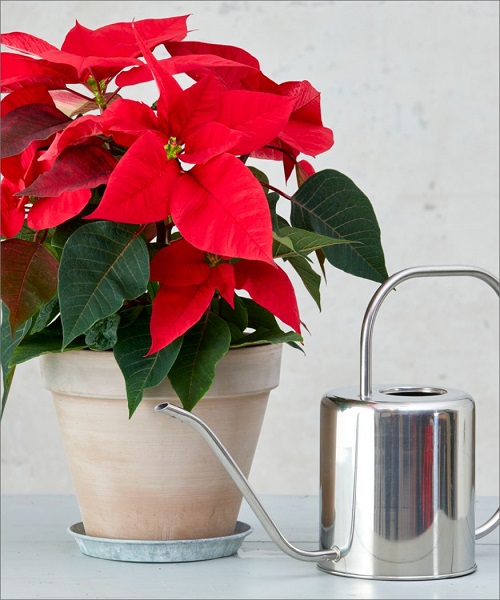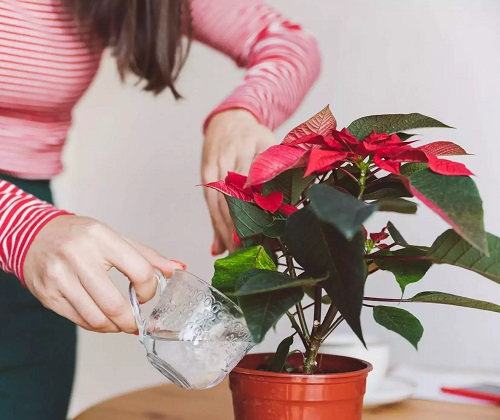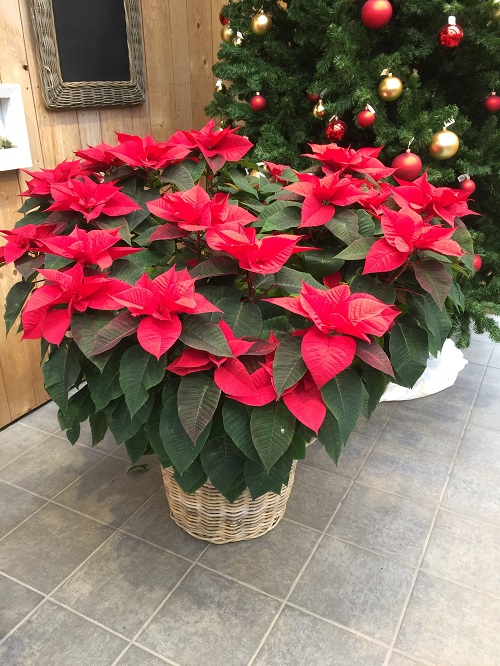Not sure about How Often to Water Poinsettias? Don’t worry, we have a detailed guide for you to ensure you keep these plants healthy and thriving!
How Often to Water Poinsettias? If you are worried about this, then we have your back! Discover the optimal watering schedule for your poinsettias. Our guide will help you understand their unique needs and keep them thriving both indoors and outdoors.
Here is How Often to Water Mint
Understanding Poinsettias: A Peek into Their Natural Habitat
Native to the tropical deciduous forests of Mexico, poinsettias have evolved to thrive in a unique environment. These regions experience periods of heavy rainfall followed by spells of drought. Adapting to these conditions, poinsettias have developed characteristics similar to succulents. They store water in their robust leaves and stems, allowing them to survive periods of water scarcity.
Understanding these conditions can help us mimic their natural watering patterns. In general, poinsettias prefer a “soak and dry” watering approach. This method involves watering the plant thoroughly until water begins to drain out from the bottom of the pot. Then, you allow the top layer of soil to dry out before watering again. To prevent waterlogging and root rot, a well-draining soil mix is recommended.
Here is How to Grow a Big Poinsettia as a Tree
Determining Watering Frequency for Poinsettias
1. Location-Specific Needs: Indoors vs Outdoors
The location of your poinsettia significantly impacts its watering needs. If you are growing your poinsettia indoors, where it receives indirect light and is sheltered from wind and temperature fluctuations, the soil will dry out at a slower pace. In this case, you should check the soil’s moisture level every 8-10 days.
On the other hand, if your poinsettia is outdoors, where it’s exposed to more direct sunlight and variable weather conditions, the soil will dry out faster. In such situations, you should monitor the soil’s moisture every 5-7 days.
However, it’s crucial to remember that these are general guidelines. Actual watering needs can vary based on several other factors, including local climate, humidity levels, and the specific characteristics of your poinsettia.
Find How to Buy the Best Poinsettias here
2. Seasonal Watering Guidelines for Poinsettias
Like many plants, poinsettias have different watering needs depending on the season. During the warmer months, evaporation rates are high, potentially necessitating more frequent watering.
An indoor poinsettia might need watering every 10-12 days during warm weather, depending on how quickly the soil dries. For outdoor poinsettias, which are more exposed to the sun, you might need to water them every 5-7 days.
In contrast, during colder months, evaporation rates decrease significantly. Both indoor and outdoor poinsettias might only need watering every 14-20 days during this time. However, these intervals can change based on specific weather conditions and how quickly the soil dries out.
Learn How to Get a Poinsettia to Turn Red here
Selecting the Right Pot Size for Poinsettias

The size of your poinsettia pot is more critical than you might think. Small or crowded pots can dry out faster due to limited soil volume, leading to more frequent watering needs. On the flip side, a larger pot will retain more moisture, reducing the need for frequent watering.
Pro Tip: To find a balanced middle ground, choose a pot that’s one size larger than your poinsettia’s root ball. This approach ensures the plant has enough room to grow without risking overwatering due to an overly large pot.
Here are Plant Pot Sizes from Inches to Gallon
Before Watering: Conducting a Quick Soil Check
Before you start watering your poinsettia, it’s crucial to perform a quick check on the soil’s moisture level. This check can be as simple as pushing your finger into the soil up to the first knuckle. If the soil feels dry, it’s time to water your plant. If it’s still damp, wait a few days before rechecking. This method helps prevent both overwatering and underwatering.
Poinsettia Watering Tips
Here are a few additional tips to keep your poinsettia healthy:
- Quality of Water: Use filtered, rain, or well water to prevent an excess of mineral salts from building up in the soil. Alternatively, let tap water sit overnight to allow chlorine and other additives to dissipate before use.
- Watering Technique: Water thoroughly until the water drains out from the bottom of the pot. This ensures the soil is properly hydrated.
- Avoid Wetting the Foliage: Poinsettias, like most succulent-like plants, prefer their leaves to remain dry. Keeping the foliage dry helps prevent potential fungal diseases.
- Room Temperature Water: Always use room-temperature water to prevent shocking the plant’s roots.
- Don’t Mist: Unlike some other houseplants, poinsettias don’t respond well to misting. Keep your mister for other plants in your collection.
Here is How Often to Water a Snake Plant
How Often to Water Poinsettias – Frequently Asked Questions
1. How Often Should I Water Poinsettias?
The frequency of watering poinsettias depends on various factors such as their location (indoors vs outdoors), the season, and the pot size. Generally, check the soil moisture every 8-10 days for indoor poinsettias and every 5-7 days for outdoor ones.
Water them thoroughly when the top layer of soil is dry to the touch.
2. How Much Water Do Poinsettias Need?
Poinsettias prefer a “soak and dry” method. Water them thoroughly until water drains out of the bottom of the pot. Then, let the top layer of soil dry out before watering again.
3. What are the Key Poinsettia Watering Tips?
Some key tips include using filtered, rain, or well water to reduce mineral build-up in the soil; watering thoroughly and allowing the soil to dry before the next watering; avoiding wetting the foliage to prevent fungal diseases; and always using room temperature water.
4. Can I Mist My Poinsettia?
It’s not recommended to mist poinsettias. As succulent-like plants, they prefer their leaves to remain dry to prevent potential fungal diseases.
Watering your poinsettia correctly is essential for its health and longevity. By following these guidelines and understanding your poinsettia’s specific needs, you can keep it healthy and vibrant throughout the year.






